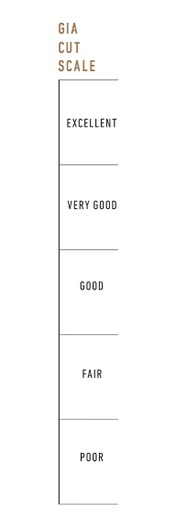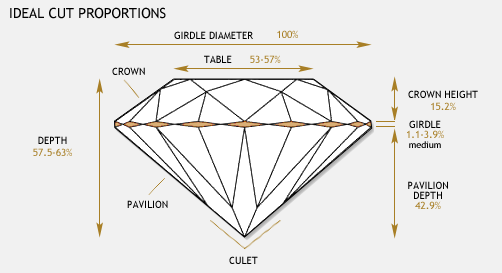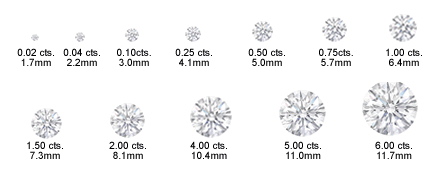Discover Diamonds
Jewellery professionals use a systematic way to evaluate and discuss diamond quality factors. Otherwise, there would be no way to compare one diamond to another and there would be no way to evaluate the qualities of an individual diamond. Diamond professionals use the GIA grading system developed in the 1950s, which established the use of four important factors to describe and classify diamonds: Colour, Clarity, Cut, and Carat Weight.
These are commonly known as the 4 C’s.
When used together, they describe the quality of a finished diamond. The value of a finished diamond is based on this combination.
Today, the descriptions of each of the 4 C’s are more precise than those applied to almost any other consumer product; and they have a long history. Three of them – colour, clarity, and carat weight – were the basis for the first diamond grading system established in India over 2,000 years ago.
Colour
The diamond colour evaluation of most gem-quality diamonds is based on the absence of colour. A chemically pure and structurally perfect diamond has no hue, like a drop of pure water, and consequently, a higher value. GIA’s D-to-Z diamond colour-grading system measures the degree of colorlessness by viewing a stone under controlled lighting and precise conditions.
GIA’s diamond D-to-Z colour-grading scale is the industry’s most widely accepted grading system. The scale begins with the letter D, representing colourless, and continues, with increasing presence of colour, to the letter Z.
Many of these colour distinctions are so subtle that they are invisible to the untrained eye; however, these distinctions make a very big difference in diamond quality and price.

Clarity
Natural diamonds are the result of carbon exposed to tremendous heat and pressure deep in the earth. This process can result in a variety of internal characteristics called ‘inclusions’ and external characteristics called ‘blemishes’.
Evaluating diamond clarity involves determining the number, size, relief, nature, and position of these characteristics, as well as how these affect the overall appearance of the stone. While no diamond is perfectly pure, the closer it comes, the higher its value.
The GIA Diamond Clarity Scale has 6 categories, some of which are divided, for a total of 11 specific grades.
• Flawless (FL) -- No inclusions and no blemishes visible under 10x magnification
• Internally Flawless (IF) -- No inclusions visible under 10x magnification
• Very, Very Slightly Included (VVS1 and VVS2) -- Inclusions so slight they are difficult for a skilled grader to see under 10x magnification
• Very Slightly Included (VS1 and VS2) -- Inclusions are observed with effort under 10x magnification, but can be characterized as minor
• Slightly Included (SI1 and SI2) -- Inclusions are noticeable under 10x magnification
• Included (I1, I2, and I3) -- Inclusions are obvious under 10x magnification
Many inclusions and blemishes are too tiny to be seen by anyone other than a trained diamond grader. To the naked eye, a VS1 and an SI2 diamond may look exactly the same, but these diamonds are quite different in terms of overall quality. This is why expert and accurate assessment of diamond clarity is extremely important.

Cut
Diamonds are renowned for their ability to transmit light and sparkle so intensely. We often think of a diamond's cut as shape (round, emerald, pear), but a diamond's cut grade is really about how well a diamond’s facets interact with light.
Precise artistry and workmanship are required to fashion a stone so its proportions, symmetry, and polish deliver the magnificent return of light only possible in a diamond.
A diamond’s cut is crucial to the stone’s final beauty and value. And of all the diamond 4 C’s, it is the most complex and technically difficult to analyze.


Carat Weight
Diamond carat weight is the measurement of how much a diamond weighs. A metric "carat" is defined as 200 milligrams.
Each carat can be subdivided into 100 ‘points’. This allows very precise measurements to the hundredth decimal place. A jeweller may describe the weight of a diamond below one carat by its ‘points’ alone. For instance, the jeweller may refer to a diamond that weighs 0.75 carats as a ‘seventy-five pointer’. Diamond weights greater than one carat are expressed in carats and decimals. A 1.08 carat stone would be described as ‘one point oh eight carats'.
All else being equal, diamond price increases with diamond carat weight, because larger diamonds are more rare and more desirable. But two diamonds of equal carat weight can have very different values (and prices) depending on the three other factors of the diamonds’ 4 C’s: Colour, Clarity, and Cut.
It's important to remember that a diamond’s value is determined using all of the 4 C’s, not just carat weight.

Shape
Shapes other than the most common Round Brilliant Cut are called Fancy Cuts. They’re sometimes called fancy shapes or fancies. Fancy shapes have names of their own, based on their shapes. The best known are: Princess, Oval, Asscher, Marquise, Heart, Cushion, Radiant, Pear, and Emerald Cut.
